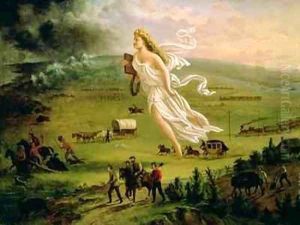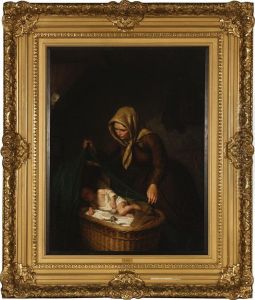John Gast Paintings
John Gast was an American painter born in Berlin, Prussia, in 1842. He is most famously known for his 1872 painting 'American Progress,' which personifies the concept of Manifest Destiny, the 19th-century doctrine that justified American expansion across the continent. The painting, which became an iconic representation of this period, depicts a floating female figure named 'Columbia,' symbolizing progress and civilization, leading settlers westward, while Native Americans and wild animals flee into the shadows of the painting's edges.
Gast's work, particularly 'American Progress,' is a striking visual summary of the period's optimistic belief in the inevitable growth and moral righteousness of the United States. The painting was widely distributed as an engraving, reflecting and promoting the idea that the expansion of the United States was both obvious ('manifest') and inexorably destined ('destiny').
During his lifetime, John Gast was known as a genre painter, lithographer, and illustrator. His works often reflected the themes of his era, engaging with subjects of westward expansion, American identity, and the transformation of the landscape. He immigrated to the United States with his family as a child, and they settled in Brooklyn, New York. Gast's early art career involved working as a lithographer, which was a common trade for artists of the time, as it allowed them to reproduce their works widely.
John Gast's career as an artist was reflective of the broader movements within American art, particularly the influence of Romanticism and the burgeoning sense of American exceptionalism. His works served as visual companions to the narratives of American growth and the belief in the young nation's manifest destiny. He continued to work and live in Brooklyn until his death in 1896. Though not as widely recognized as some of his contemporaries, Gast’s 'American Progress' has endured as an important cultural artifact, encapsulating the spirit of an era in American history.



